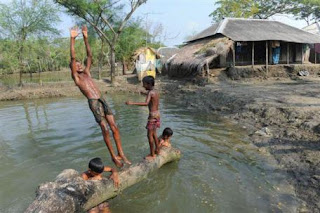Flooding forces Samya Begum to abandon her home at least once every year.
For Samya Begum, hunger is never far away. She lives in a part of
GAIBANDAH – Every monsoon season, Samya is on edge, wondering when the flood will come and whether there will be a warning. If there’s a warning, she and her family can collect a few basic items from their bamboo hut and move to higher ground. If not, they abandon everything and flee.
This year the family got off quite lightly. Flooding in Samya’s village on the
"It won’t be long before my home is flooded and we have to move again," says the 23-year-old mother patiently, as she fries up WFP wheat flour for her disabled husband and their two children.
Precarious existence
Many families in Samya’s community have to flee their homes every year. The precariousness of this existence is one reason why it is so hard to escape poverty and vulnerability to hunger.
In an effort to help Samya build a better future, WFP and the
"I want to get out of poverty and my dream is to be a goat and cow herder," says Samya, who is now doing small-scale poultry farming as a way of trying to achieve some ‘food security’.
The VGD programme is aimed at the most marginalised women in
Poorest suffer
During severe floods, it is the poorest and most vulnerable who suffer most because their houses are often in more exposed locations.
WFP has been working for many years, not only to support climate-vulnerable populations with food assistance, but also to help them adapt to climate change. They can do this by raising their homesteads on plinths and building protective embankments and roads to keep them linked to markets. WFP is also involved in training on how to survive during increasingly frequent natural disasters.



No comments:
Post a Comment